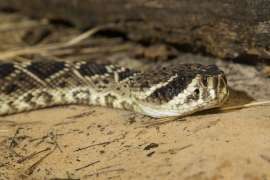Eastern Diamondback Rattlesnake
Eastern Diamondback Rattlesnake
Eastern diamondback rattlesnakes are the largest venomous snakes the U.S. They are maligned and slaughtered, both opportunistically by rural citizens and systematically in locally promoted rattlesnake roundups. Despite their large size and the medical importance of the rare accidental bite to a human, these are quiet and reclusive snakes that do very little harm unless harassed or restrained.
Crotalus adamanteus
Venomous
Carnivore
North America [VIEW MAP]
Grasslands, Woodlands
These snakes may usually be seen in their large habitat in the indoor gallery of Scaly Slimy Spectacular.
Photos and Videos
The largest venomous snake in the U.S., the eastern diamondback rattlesnake may reach lengths of almost 8 feet. Their name comes from the distinctive series of ark brown diamonds, outlined in white, running down their back.
As is the case in all rattlesnakes, new rattle segments are added each time they shed their skin. Because these are not annual events, one cannot estimate the age of the snake by counting the rattles. As pitvipers, eastern diamondback rattlesnakes also have the second set of infrared-sensitive eyes on the face in the form of two forward-facing pits that focus infrared images in the same manner as a pinhole camera, as well as the long, folding fangs used to inject venom into prey or potential predators.
These snakes may live over 20 years. The males are larger than the females. This may be a result of selection for large males that will win the arduous male–male, non-lethal wrestling contests that allow the winner to breed with a nearby female.
Females will produce a clutch of up to as many as 20 live-born babies that are especially large in size. The myth that baby diamondback rattlesnakes hide underground, and grow for a few years before surfacing, likely comes from the fact that few people realize that an 18-inch rattlesnake is actually a newborn. Like all other rattlesnakes yet studied, the female will stay with her young and protect them until their first shed cycle, at which time they will disperse on their own.
These snakes may usually be seen in their large habitat in the indoor gallery of Scaly Slimy Spectacular.
These historically ranged along the Coastal Plain of the southeastern U.S., from Louisiana to North Carolina, and the entire Florida Peninsula. They are now missing from parts of their historic range, with healthy populations appearing to persist only in parts of southern Georgia and Florida.
While usually associated with longleaf pine forests, these snakes also will use sandhills, pine flatwoods, coastal scrub, and other habitat types.
In the wild, these snakes eat primarily small mammals, especially cotton rats and cottontail rabbits, as well as some birds. An interesting exception appears to be the Virginia opossum, an abundant mammal across their range, which is immune to the venom of this rattlesnake. So, it is uncommon for opossums to fall prey to these large predators.
Zoo Atlanta is an active partner with Georgia Department of Natural Resources, the NGO Orianne Society, University of Georgia, and other organizations to eliminate the last few active rattlesnake roundups in Georgia, and to explicitly support programs such as those initiated by the town of Claxton, Georgia, to convert their former rattlesnake roundup to a more progressive and non-lethal celebration of Georgia’s wonderful wildlife.
More on Zoo Atlanta’s Conservation Efforts [link]






